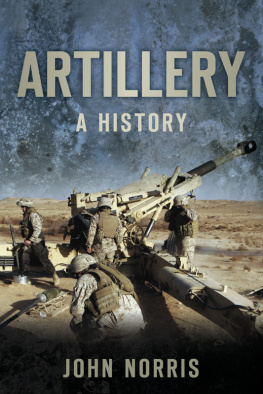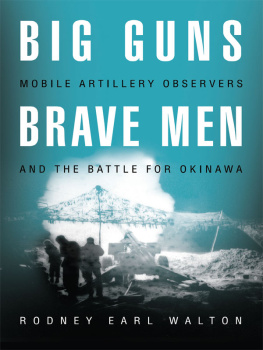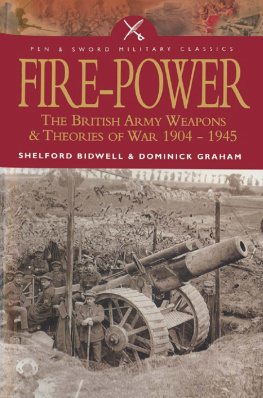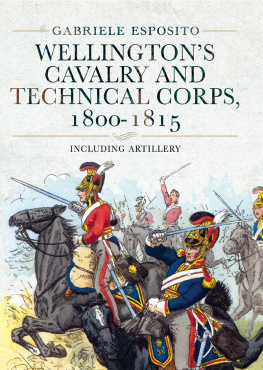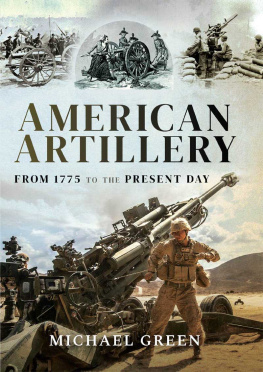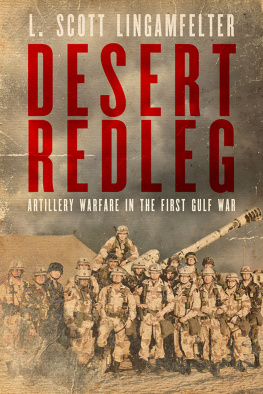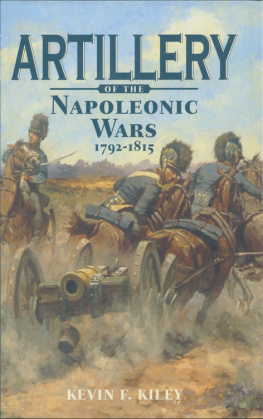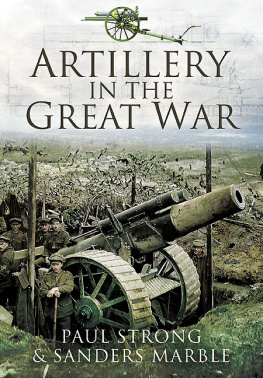Field Artillery and Firepower
J.B.A. Bailey

The Military Press Oxford
A Member of the Taylor & Francis Group
New York Philadelphia London
This edition published in the Taylor & Francis e-Library, 2009.
To purchase your own copy of this or any of Taylor & Francis or Routledges collection of thousands of eBooks please go to www.eBookstore.tandf.co.uk.
UK Publishing Office: Military Press Ltd 92A Church Way
Iffley, Oxford OX4 4EF
Sales Office: Taylor & Francis Ltd Rankine Road
Basingstoke, Hants RG24 OPR
USA Sales Office: Taylor & Francis Inc
242 Cherry Street
Philadelphia, PA 191061906
1989 Jonathan Bailey
All rights reserved. No part of this publication may be reproduced, stored in a retrieval system or transmitted, in any form or by any means, electronic, electrostatic, magnetic tape, mechanical, photocopying, recording or otherwise, without the prior permission of the copyright owner.
British Library Cataloguing in Publication Data
Bailey, Jonathan B.A.
Field Artillery and Firepower.
1. Field Artillery. Tactics, to 1987
I. Title 358.1209
Library of Congress Cataloging in Publication Data available
ISBN 0-203-39299-X Master e-book ISBN
ISBN 0-203-39582-4 (Adobe ebook Reader Format)
ISBN 0-85066-810-7 (Print Edition)
ISBN 0-85066-811-5 Pbk
Foreword
Major Jonathan Bailey is a serving officer in the Royal Artillery who has researched and written this book in his spare time over the last few years. During this period he has served with the Commonwealth Monitoring Force in Rhodesia, with 5 Brigade in the Falklands, in Northern Ireland and, latterly, as a battery commander with the British Army of the Rhine. He has, therefore, a wide experience of conventional operations and has taken a deep professional interest in the history and current developments of his own Arm, the Royal Artillery.
In his introduction, the author states that it is hard to find a book which presents the principles of field artillery tactics, how these have developed with experience against a background of changing strategy and technology, and what the future may hold as a consequence. I have found it impossible!
There are books which cover some ground similar to Baileys, although the majority have historical slants. Chris Bellamys Red God of War: Soviet Artillery and Rocket Forces deals with territory similar to Baileys chapters on the Second World War and NATO. B.P.Hughess Open Fire considers how artillery was handled in battle in the eighteenth and nineteenth centuries only. Shelford Bidwells Gunners at War is a tactical study of the Royal Artillery, mostly in the two World Wars, and covers similar ground to Baileys chapters on the development of fire support, as does Kenneth Brookess study Battle Thunder. Finally, Shelford Bidwell and Dominick Grahams Fire-Power is an excellent historical/tactical treatise, but it uses an historical approach and does not trespass on Baileys territory. From this it follows that I agree with Jonathan Bailey when he states that he has identified a gap in the literature concerned with field artillery, and I commend him for identifying this and producing such a scholarly magnum opus.
Throughout his book the author traces the ebb and flow of the importance of artillery through the centuries. He rightly states that at different periods of history artillery has been seen either as the decisive arm on the battlefield or, more often, as the arm which merely supports the front-line troops who will decide the outcome of the battle. After reading his analysis, certain conclusions become evident. Artillery when used in penny packets fails. When used in concentrated fashion at the crucial point of a battle it produces shock action than can neutralise, paralyse and destroy the enemy and weaken his will to win. As Montgomery said, the concentration of artillery and mortars is a battle-winning factor of the first importance. Artillery produces the firepower of fire and manoeuvre at formation level; it allows ones own side to close right up to the enemy or conversely prevents the enemy from closing up to you. The more you have, the greater the chance of success. Artillery can be used to gain tactical surprise, or as an aid to deception. It is inherently flexible and can be used in all weathers, day and night. In time of war, a commander always demands more artillery than he is allocated and, sadly, in times of peace the value of artillery and the lessons learned through history are nearly always forgotten.
One of the most interesting parts of the book is the authors glimpse into the future and his emphasis on the deep battle. Not every reader will agree with his contentions that the significance of the deep battle will soon be comparable with that of the close battle of forty or seventy years ago; and artillery will be judged in future primarily by its performance in this engagement, not in close support. I think Bailey is right to highlight the increasing importance of the deep battle, now that sophisticated target acquisition devices are entering service combined with missile systems which can destroy armour. It is clear that if indirect fire, including air-delivered munitions, can prevent an enemy re-inforcing his troops in contact, then friendly forces engaged in the contact battle have a much greater chance of achieving success. That said, an army will always need to hold or seize ground, and to that end the requirement still exists for properly balanced all arms battle groups with access to substantial artillery support. The difficulty facing all Western armies is the need to balance the resources required to fund weapon systems for both the contact and the deep battles. It is certain that money will not be available for everything and, in terms of the future of artillery, Bailey has come down firmly on the side of the deep battle. He may well be right, even though some Gunners from the past may either disagree or have reservations.
I hope his book will be enjoyed by a wide field of readers encompassing professional soldiers, academics and civilians alike. I would venture to suggest that Bailey has done for Artillery what Richard Simpkin did for Armour in his excellent book Tank Warfare. I can give no higher praise or greater commendation.
J.H.Learmont CBE
Major General
Commandant, Staff College
Camberley
Acknowledgements
My thanks are due to the staff of the following libraries: the Ministry of Defence Library in Whitehall, the Royal Artillery Institution Library at Woolwich, the Badley Library at the Royal School of Artillery, the Prince Consort Library in Aldershot, the Staff College Library at Camberley and the British Garrison Library in Osnabrck. The Tactical Doctrine Retrieval Cell at the Staff College Camberley, the Soviet Studies Research Centre at the Royal al Military Academy Sandhurst and the publication Current Military & PoliticalLiterature all helped to simplify the task of research.
The following individuals were of notable assistance: Brigadier I.G.Townsend, Brigadier J.J.G.Mackenzie OBE, Colonel T.J.Bremridge, Lieutenant Colonel J.M. Patrick MBE, Lieutenant Colonel D.Gay, Lieutenant Colonel R.P.Cousens, Lieutenant Colonel P.R.Horobin, Oberstleutnant von Arnim, Major L.Brown (U.S.Army), Major J.A.Eden MBE, Major J.D.Lang, Major J.A.C.Bazzard, Major M.G.Houghton, Major B.Bennett and Sergeant J.Muir.



